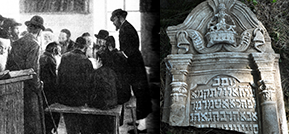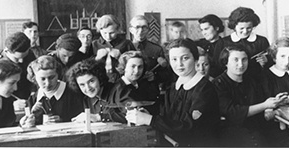For the past three years the Jewish Galicia and Bukovina project has been sending field schools to document and preserve Jewish remnants in Eastern Europe. This year's field school destination was Pidhaytsi, a quiet and pastoral town in Eastern-Galicia 62 miles South-West of Lviv. Its pastoral setting notwithstanding, Pidhaytsi was one of the more important and developed towns in the entire region. The name Pidhaytsi, which means "in the woods" is drawn from its location in the heart of the most forested area in today's Ternopil region in western Ukraine.
Pidhaytsi is one of the oldest towns in Galicia with records as far back as 1463 when the Catholic Church was built by the regional Governor Potocki. During the Polish royal dominion Pidhaytsi was a major checkpoint on a main merchants' road from Snyatyn through Pidhaytsi to Lviv. Due to the many people passing through the town it was known for its fairs.
The Jewish community of Pidhaytsi was one of the oldest communities in Galicia dating back to the 16th century. Towards the end of the 17th century many Jews of Pidhaytsi were killed by Turks and Tatars. According to the census of 1764 there were 1,765 Jews registered in the Kahal (the Jewish community board) of the Pidhaytsi district, of which 1079 lived in Pidhaytsi itself. In the 19th century the Jewish community grew rapidly and by 1910 there were 6000 Jews in Pidhaytsi constituting 60% of the population. In the interwar period the community decreased and by 1939, 3200 Jews remained in the town.
Due to its location on the cross road between different cultures, Pidhaytsi became a fertile ground for mystical movements. In the case of the Jewish community the first such movement was the "messianic" Sabbatean movement and it caught the hearts of many Jews. The first Sabbatean to preach in Pidhaytsi was a known mystic figure by the name of, Chaim Malakh who stood in the head of a Jewish mystical group which came to Erez-Israel in 1700. The Hasidic movement was also very influential in the Pidhaytsi area. 5 well known Galician Hasidic Zaddiks lived in the Pidhaytsi area. The same can be said about Christian ascetics and hermits who found Pidhaytsi's surrounding appropriate for establishing monasteries, one of which is still active.
Pidhaytsi was one of the most important Jewish communities in Galicia because of the notable rabbis that came from this town. The first rabbis of the town were Rabbi Moshe and his son Rabbi Yehuda Leib in the 16th century. The most famous rabbi to lead the community of Pidhaytsi was Rabbi Benjamin Aharon Solnik (1530-1620), known for his book "Masa't Benaymin"(Benjamin's Mess). Culturally the Jewish community was very diverse, much like the rest of Galician Jewry.
In World War I the town was severely damaged and most of the town's homes were burnt. Many of the Jews of Pidhaytsi left the town that became the battle ground between the Austrian and Russian armies.
When the town was occupied by the Nazi Germany in 1941 there were more than 3000 Jews in Pidhaytsi, some of which were refugees who came to the town in the first years of WWII. On Yom-Kippur 1942, 1000 Jews were sent to Belzec death camp. The rest were closed in a small ghetto where many died from hunger and disease. On June 6th, 1943 the remaining Jews in the ghetto were killed in mass graves in the outskirts of the town.
The remaining of this once vibrant Jewish community are an old cemetery and an abandoned synagogue. In the summer of 2011 a group of 15 students made up of torah scholars from the "Siach Yitzhak" Yeshiva, students from the Ben-Gurion University and the Universities in St. Petersburg went out to document and research the remains of Jewish Pidhaytsi. The team was lead by Dr. Boris Khaimovich from the Hebrew University in Jerusalem and Ms. Marina Bruk from the State University in St. Petersburg. This combination of the torah and academic worlds created a unique atmosphere in the research group which suites the universal character of Jewish Galician culture.
The main focus of the field school was the large and ancient Jewish cemetery. The team documented the entire cemetery which contains over 1500 tombstones (the oldest from the 16th century). The tombstones were numbered, photographed, measured and their epitaphs transcribed. Some of the tombstones were dug out of the ground and raised on their place. A detailed map of the cemetery was prepared by local land-surveyors.
The field school to Pidhaytsi continues the remarkable, pioneering work of the 2009 and 2010 field schools in the pursuit after Jewish history in Galicia and Bukovina.
The team was accompanied by an Israeli press team. The article can be seen here(in Hebrew).
In the following weeks the materials gathered by the field school will be processed and presented to the public on the website.
Read more about the Jewish community in Pidhaytsi here
View more Photos of Pidhaytsi here






